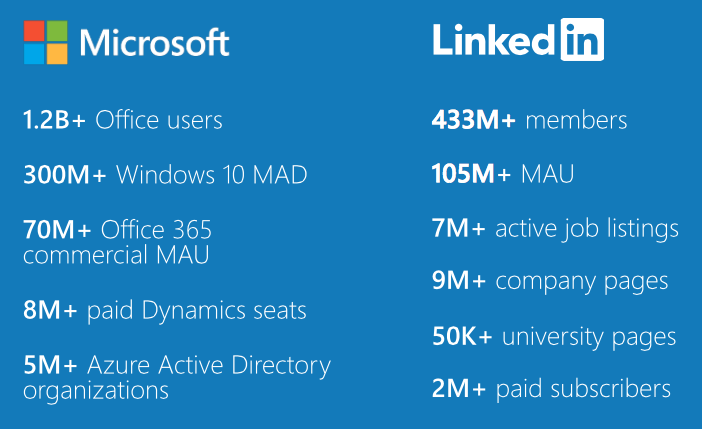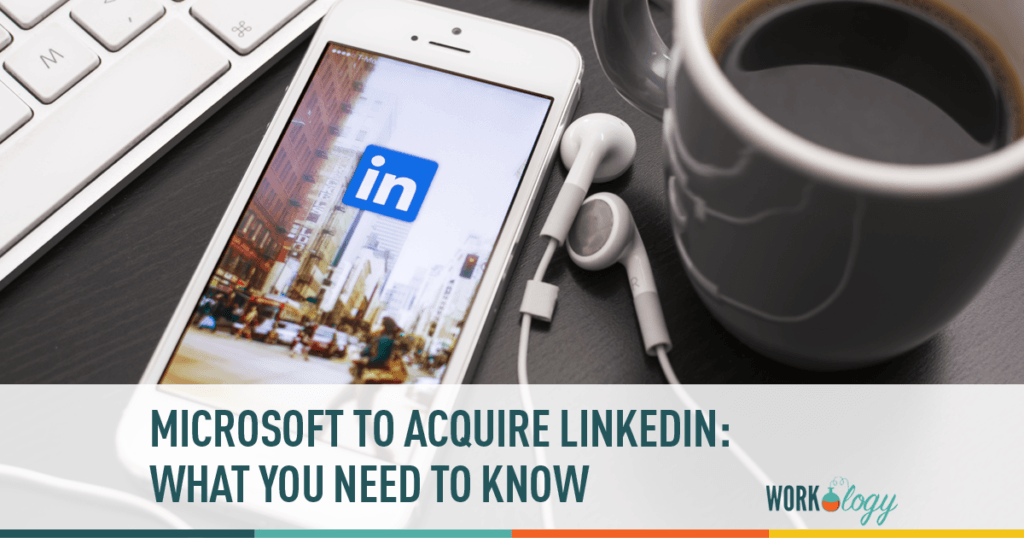This morning Microsoft CEO Satya Nadella and LinkedIn CEO Jeff Weiner sat down together to announce that Microsoft is planning to acquire LinkedIn for $26.2 billion — in cash. The deal has been approved by both boards — unanimously even — but still must pass regulatory approval, and is Nadella’s first big acquisition since becoming CEO two years ago. It gives the company a dramatically increased reach in the enterprise services sector, a leap forward in social networking, and a deep pool of data on LinkedIn’s users.
LinkedIn will retain operational and branding independence and Weiner will remain on board as its CEO.
You can find more details about the transaction in these conference call notes. The call, which will include Microsoft and LinkedIn employees and investors is set for 8:45 AM PST.
https://youtu.be/-89PWn0QaaY
Nadella said that the big draw of LinkedIn is how Microsoft might combine productivity and communication tools with its established professional network, a kind of holistic professional development and learning platform for your whole working life. So although LinkedIn will continue to operate independently and offer the same services it always has, for Microsoft customers and for paying LinkedIn users it’s about to start offering a lot more, including deep integration with Microsoft tools.
From Recruiting and Networking to “Human Capital”
As TechCrunch points out, “LinkedIn’s core business is based today around recruitment ads and, to a lesser extend, premium subscriptions for users. The recruitment business (termed “Talent Solutions”) accounted for $2 billion of the company’s $3 billion in revenues in 2015.” The LinkedIn acquisition, 4 years after they picked up Yammer, doesn’t just give Microsoft a successful social network to call their own (and mine for data and sales), it also makes them a big player in the talent and recruitment space, one of the fastest growing areas in enterprise software. HR tech is big business and it’s only growing.
But Microsoft and LinkedIn want to more than just dominate recruiting, they want to build a holistic “human capital” business.
Weiner indicated that LinkedIn and Microsoft will build from its foundation in recruiting and networking into the wider businesses of productivity, organization and personal and professional development. LinkedIn will “[expand] beyond recruiting and learning & development to create value for any part of an organization involved with hiring, managing, motivating or leading employees. This human capital area is a massive business opportunity and an entirely new one for Microsoft.” For human resources and recruitment professionals, this means that their favourite social network is about to get much more useful, with more tools, and potentially. Tool integration also promises to offer combined organization, workforce and talent data, all in one place.
New Tools and New Sales Opportunities
In his public letter to Microsoft staff, Nadella emphasized that the integration of Microsoft and LinkedIn products would not just benefit users but also offer both companies new sales and advertising opportunities.
“Along with the new growth in our Office 365 commercial and Dynamics businesses this deal is key to our bold ambition to reinvent productivity and business processes. Think about it: How people find jobs, build skills, sell, market and get work done and ultimately find success requires a connected professional world. It requires a vibrant network that brings together a professional’s information in LinkedIn’s public network with the information in Office 365 and Dynamics. This combination will make it possible for new experiences such as a LinkedIn newsfeed that serves up articles based on the project you are working on and Office suggesting an expert to connect with via LinkedIn to help with a task you’re trying to complete. As these experiences get more intelligent and delightful, the LinkedIn and Office 365 engagement will grow. And in turn, new opportunities will be created for monetization through individual and organization subscriptions and targeted advertising.”
Both Nadella and Weiner emphasized the importance of the continued growth of the LinkedIn userbase, and in his own letter to LinkedIn staff, which he published here, Weiner pointed to the company’s successes in this area. Despite the ups and downs its experienced over the last few years, LinkedIn has grown dramatically. Since Weiner came on board in 2008, its membership has gone from 32 million to 433 million and its revenue has gone from $78M to over $3 billion. Nadella and Weiner both say that it’s time to push the pace of growth even further — and they hope to do it by providing even more value to casual users and paying customers. LinkedIn sponsored content customers will be able to take advantage of the Microsoft network. Microsoft will, through LinkedIn, offer a suite of tools to freelancers. And presumably, LinkedIn will integrate with Microsoft’s organizational and communicative tools so that it can act as an internal as well as external social network.

For Microsoft and LinkedIn, this acquisition has the potential to be a big win. LinkedIn has struggled to build the tools its users really want, but integration with Microsoft allows them to do just that without having to do all the development work. Microsoft, meanwhile, gets access to a huge network of working professionals and data and a foothold in HR tech.
Users too, both paid and unpaid, stand to benefit from the acquisition. Although every such acquisition comes with user experience hiccups, both LinkedIn and Microsoft benefit most from building on, not changing their existing offerings. There’s nothing to gained, for example, from alienating free users, however, there’s a lot to be gained from earning their loyalty and converting them to paying customers.
Microsoft is currently seeking regulatory approval in the US, EU, Canada and Brazil and expects the deal to close before the end of the calendar year. In the meantime, the two companies will be working on developing their shared vision into actual product offerings, so expect to hear a lot more from them in the coming months.








